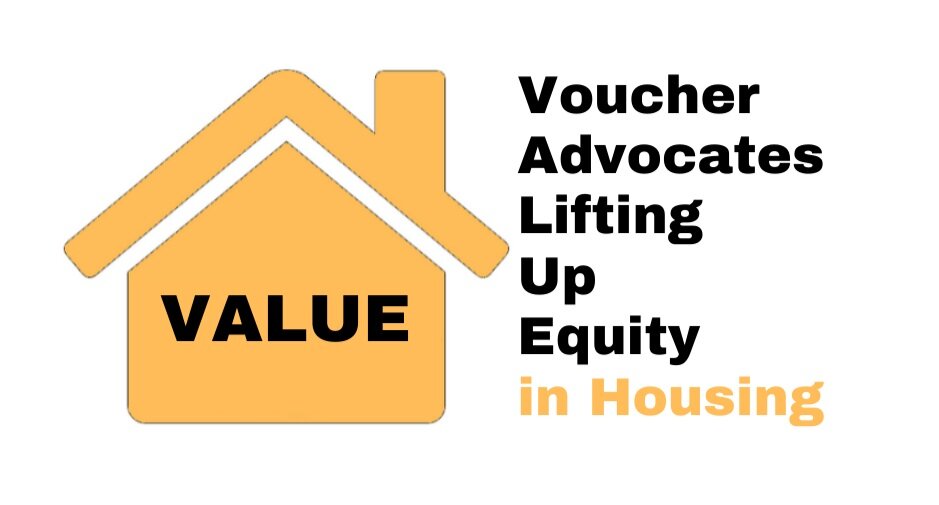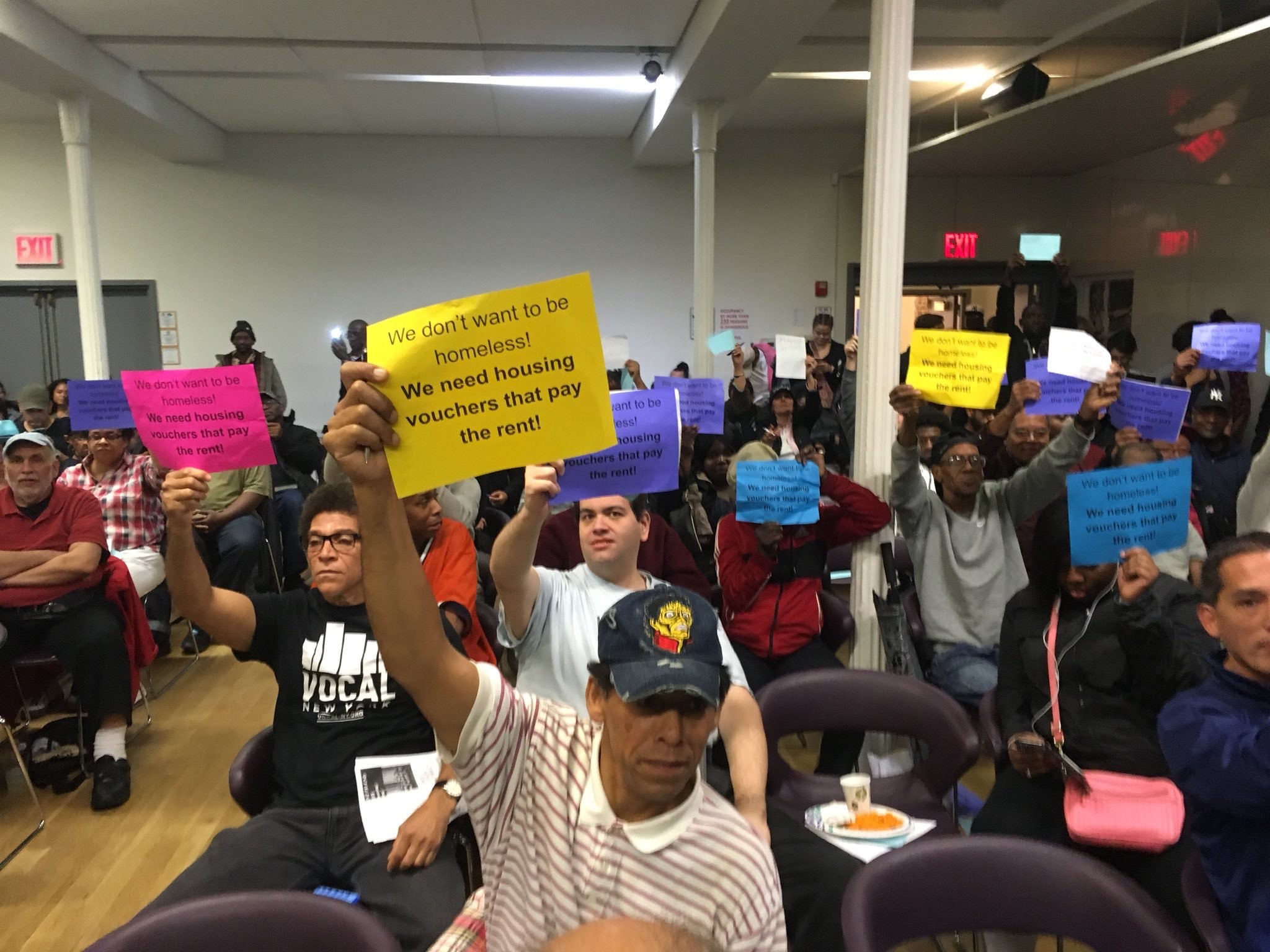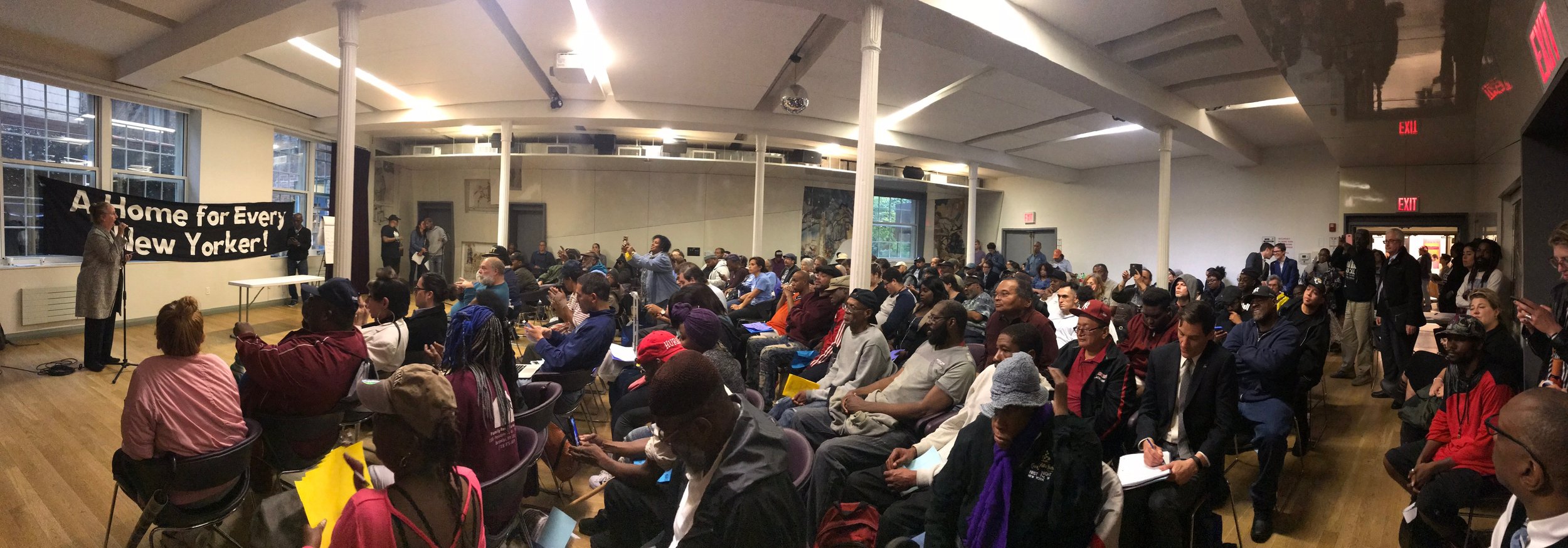Voucher Holders and Advocates Gather to Discuss the new CityFHEPS voucher with Commissioner Steve Banks
On September 25th, over 200 voucher holders and advocates gathered at the LGBT Center in Manhattan to ask Commissioner Steve Banks questions about the new CityFHEPS voucher introduced by the Human Resource Administration (HRA).
Commissioner Banks speaking about the voucher consolidation rule change.
Commissioner Banks, who leads the Department of Social Services (DSS), the umbrella agency that encompasses both HRA and the Department of Homeless Services (DHS), announced a proposed rule change to the city voucher programs in July of 2018. The city vouchers formerly known as LINC, SEPS and CityFEPS are to be consolidated into a new program called CityFHEPS. This move is attributed to the need to simplify the administrative burden of the voucher programs, and intends to address broker/landlord confusion over the subtle nuances between programs that has contributed to the spread of misinformation and mistrust around rental assistance vouchers.
The rent amounts for the new CityFHEPS voucher mirror the New York State FHEPS voucher, and attempts to target populations formerly served by either LINC, SEPS or CityFEPS - including individuals and families who are currently homeless, and those in danger of becoming homeless.
While many advocates feel like this is a step in the right direction, the rule change has left a lot to be desired. The proposal lacked important details for current voucher holders about the transition process, explicit instructions for prospective applicants on how to apply, and made no improvements to the severe shortcomings of the previous voucher programs. At the town hall, voucher holders pressed Commissioner Banks on HRA’s lack of clarity and offered solutions to some of the program’s most ubiquitous problems, including source of income discrimination.
Councilmember Steve Levin was also in attendance, and has introduced a bill (Int. 0146) to the City Council that addresses another major flaw present in the new CityFHEPS voucher - the voucher amount itself. At its current rate, the voucher fall on average $300 below fair market rent in New York City, limiting voucher holders to few far flung neighborhoods, and even fewer unit options on the private market. Commissioner Banks opposed Int. 0146, stating it would not be feasible within the city’s budget. As a solution, the Commissioner dismissed the problem to New York State, and the fight to pass the Home Stability Support Plan. Below are all of the recommendations proposed by voucher holders and advocates at the town hall for the new CityFHEPS voucher:
Recommendations to Strengthen CityFHEPS:
Eligibility criteria
Proposed eligibility criteria are too narrow and will exclude far too many New Yorkers who are homeless but not in contact with DHS or HRA shelters:
HRA should allow all homeless youth that receive services from DYCD contracted Runaway and Homeless Youth provider to be given equal access to CityFHEPS automatically, based on the fact that they are currently homeless.
Three-quarter house tenants should have access to CityFHEPS if they are at risk of homelessness or live in dangerous conditions, including if they have no record of homelessness in a DHS or HRA shelter.
Remove eligibility requirement for street homeless individuals to receive case management services for at least 90 days from a DHS contracted outreach provider. Many street homeless individuals do not engage with or trust DHS outreach and instead may engage with other city or federally funded outreach providers (DYCD, HHS/FYSB), as well as private organizations, churches, soup kitchens, etc. Furthermore, street homeless New Yorkers are some of our most vulnerable community members – instead of requiring 90 days of engagement, we recommend that these individuals get expedited approvals so that they can get off the street and into housing as quickly as possible before their health further deteriorates. This practice is supported by the “Housing First” model.
Homelessness prevention efforts must be expanded in the new voucher. For families facing eviction, CityFHEPS only covers veterans, those in rent controlled apartments, those with previous DHS shelter history, recipients of APS services, or direct referrals from a select list of CityFHEPS qualifying programs. This excludes thousands of low-income families who face eviction each year because their income is insufficient to pay their rent, including seniors, disabled, minimum-wage workers, and the unemployed. For many of these families, there is no subsidy to help catch them. No one should have to enter the shelter system in order to get assistance.
The voucher should be expanded to also include households who will use the voucher to preserve other rent-regulated apartments, including rent-stabilized, Mitchell-Lama, and HDFC.
Not only are families becoming homeless, in some cases affordable, rent stabilized units are being lost, as people are pushed out of homes and don’t have access to rental assistance. This often gives landlords an opportunity to utilize loopholes to destabilize the apartment and increase the rent. This is in conflict with the Mayor’s goals to preserve housing.
When calculating time that an individual has spent in a shelter for the purpose of meeting the 90-day requirement, it should not matter if they have transitions between types of shelters: HRA, DHS, or DYCD.
The consolidated voucher program continues to disincentivize program recipients from working. Qualifying for the voucher requires a household to not exceed 200% of the federal poverty level. Voucher renewals after the first year require that the household’s total gross income does not exceed 250% of the federal poverty level. CityFHEPS should allow voucher holders to increase their income to a sustainable amount.
Voucher value
Maximum monthly rents should match fair market rent levels. At its current rate, CityFHEPS will not be competitive in the New York City housing market, leaving recipients in competition for units in an extremely limited pool of housing and relegating them to a few far flung neighborhoods, reinforcing economic and often racial segregation.
Increases in voucher amounts should also be tied to FMR or studies of median apartment rent, not the annual Rent Guidelines Board (RGB) vote. Most families exiting the shelter system are not able to secure rent-stabilized apartments and end up in non-regulated housing. Furthermore, this metric pits the interests of rent-stabilized tenants who have faced decades of steep increases and are now fighting for rent freezes against the interests of homeless families and individuals trying move from the shelter to stability.
Transition, application and appeals process
There is no clear referral process to access CityFHEPS for people outside of DSS and HRA shelters who are homeless or in danger of homelessness.
As long as a person remains income eligible for the program, they should have access to CityFHEPS beyond five years regardless of circumstances.
The current process to access vouchers is burdensome on homeless New Yorkers. CityFHEPS should alleviate those burdens on clients and streamline access to the program. The transition process from old vouchers to the new voucher should not be disruptive to clients receiving rental assistance.
The proposed rule requires that all CityFHEPS recipients eligible for public assistance (PA) apply for PA. HRA must work to alleviate the barriers that people face when opening a PA case. HRA should create a waiver for this requirement since some individuals have significant disabilities or barriers that prevent them from complying with the PA application process and ongoing requirements.
Lease renewals
The new voucher does not include the same guaranteed lease renewal language as the previous rental assistance programs did. This puts people at risk of not having their lease renewed after their first year, despite maintaining eligibility for the program.
If someone is facing eviction, they should receive rapid rehousing services by a city contracted provider to help them avoid returning to homelessness.
Public education
The City must undertake a broad public education campaign to increase understanding of the consolidated voucher among landlords and brokers.
The City must ensure that DSS contracted housing specialist and case managers understand the new voucher, and are trained in how to transition clients from old vouchers to the consolidated voucher.
Current voucher recipients must be educated on the new voucher and how their case will be affected.
DSS should create a handout and plan -- with input from homeless New Yorkers -- to educate current or potential voucher recipients about changes, the transition process, and who they can contact with questions.
Ambiguities in language
The City must clarify language in the proposed rule, particularly the “good cause” language. There should be a clear definition of what constitutes “good cause” so that determinations on future eligibility, appeals, and access are guided by policy and not subjectivity.
The City must avoid printing phrases on voucher award letters that call into question City payments to landlords: “money is not guaranteed.” This phrase undermines the purpose of the program.
Source of income discrimination
Increase publicity on the HRA’s Source Of Income (SOI) unit purpose and contact information. Currently, the unit is highly inaccessible to the public. If direct outreach has not been done and contact information has not been distributed, the information is difficult to find.
Upon receipt of CityFHEPS or eligibility determination letters, all recipients must be given information on their legal rights as it pertains to source of income discrimination, and contact information for both the Commission on Human Rights (CCHR) and the HRA’s SOI unit. Contact information for the unit needs to be readily available on HRA’s website.
Create an automatic referral process between the HRA’s SOI unit and the CCHR, so that the burden of navigating the city’s bureaucracy doesn’t fall on people who are already struggling to address the myriad challenges that face homeless New Yorkers.
The HRA SOI unit and the CCHR must work together to exchange information whenever appropriate, identify new trends, increase public education, and brainstorm solutions. From what we understand, there is no formal interfacing happening between the two agencies.
Create mandatory source of income discrimination training for DSS contracted housing specialists and case managers. After meeting with more than 40 case workers and housing specialists at city-contracted shelter providers, we learned that staff tasked with helping homeless New Yorkers find housing lack basic understanding of source of income discrimination and how to report it.
Create a mandatory source of income discrimination reporting tool for DSS contracted housing specialists and case managers that goes directly to the HRA’s SOI unit and the CCHR.
Expedite outreach to DSS contracted housing specialists and case managers regarding the one month hold benefit that the HRA offers, as many workers at DSS contracted shelters report being unaware of this tool to help their clients access housing.
Landlords and brokers currently use credit checks as a legal way to discriminate against homeless and poor New Yorkers. Credit checks should not be a barrier to voucher holders who can guarantee rent payments.




